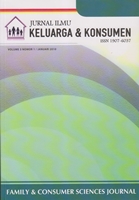HUBUNGAN FUNGSI AGIL DENGAN KESEJAHTERAAN KELUARGA NELAYAN YANG RAWAN TERKENA BENCANA ALAM
Abstract
The objectives of this study were to analyze family welfare (categorized as objective and subjective welfare) of fishermen and its correlation with family AGIL (adaptation, goal attainment, latency, and integration) functions. The study design was cross sectional. Data were collected in 2009 in Pangandaran District, Ciamis Regency (affected by tsunami in 2006), taken from 80 families (53 categorized as juragan and 27 as janggol) as the samples selected by using proportional random sampling method. By using spearman’s correlation test, it was found that there was a positive correlation between family AGIL functions and family welfare. Moreover the results of correlation test between components of family AGIL and family welfare showed that there were positive correlations between adaptation function and objective welfare, and between latency function with subjective welfare. This means that the higher the family adaptation, the higher the family income, and the better the level of family latency, the higher the level of family subjective welfare. Descriptive analysis revealed that the essential components of fishermen family subjective welfare included sincere feeling, i.e., always thank God for whatever happen and have a good satisfaction even in marginal family condition. The above results implied that, increasing family AGIL function should become a crucial factor in increasing family welfare. Indeed, strengthening family program should be emphasized on the two vital functions: adaptation and latency.
Authors submitting manuscripts should understand and agree that copyright of manuscripts published are held Jurnal Ilmu Keluarga dan Konsumen. The statement to release the copyright to Jurnal Ilmu Keluarga dan Konsumen is stated in Copyright Release Form. Copyright encompass exclusive rights to reproduce, to distribute, and to sell any part of the journal articles in all form and media. The reproduction of any part of this journal is allowed with a written permission from Jurnal Ilmu Keluarga dan Konsumen.









